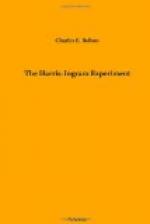The women on the committee visited the hospitals and for a time became nurses ministering to every want. Money and abundance of food were also contributed, and such kindness on the part of the rich the work-people had never known before.
The evening papers gave the authoritative statement that the total number of those killed outright by the explosions at the steel mills was one hundred and twenty-seven. Of this number eighty-six were workmen, fourteen were men who lived in the vicinity, but were not employed in the mills, ten were women, and seventeen were children. The total number of wounded was sixty-eight.
A public funeral was decided upon by the committee. The Harrisville Iron & Steel Co. sent their check for $5000 to the committee and many others contributed money. The time fixed for the public services was Sunday at 2 o’clock. Ten separate platforms for the clergy and church choirs of the city had been erected on the same open fields where the great strike meetings had so often been held. By 1 o’clock people began to assemble. Workmen came from all parts of the city, till over fifty thousand laborers with their wives were on the ground. Most wore black crepe on their arm.
Fifteen minutes before 2 o’clock solemn band music gave notice to the crowd of the approach of an imposing procession. Platoons of police led the column who were followed in carriages by the mayor, his cabinet, and the city council; then another platoon of police, followed by a long line of hearses, the black plumes of which seemed to wave in unison with the solemn tread of over a thousand workmen, acting as pall-bearers, walking in double file on either side of their dead comrades.
It was some moments before the speaking could begin. By concerted action all the clergy preached on the “Brotherhood of Mankind,” the text used being, John XV.-12. “This is my commandment, That ye love one another, as I have loved you.” The speakers were moved by the Holy Spirit. The services closed with the hymn, “Nearer my God to Thee.”
The funeral procession was several miles in length. Public and private buildings along the route to the cemetery were draped with the emblems of mourning. Twenty-five of the bodies were given private burial. Over one hundred of the victims of the dynamite disaster were buried in one common grave. Together they had died, and together they were buried. The mantle of charity covered them.
Soon after the funeral, the press contained an account of a great meeting held by the surviving workmen of the Harrisville Iron & Steel Co., and of resolutions that were unanimously adopted:—
“Resolved, That we, the surviving workmen of the Harrisville Iron & Steel Co., hereby desire to express our deep sympathy with the bereaved families of our late comrades in toil.
“That further we desire to contribute from the pay-roll due us the wages received for two days’ services, the same to be paid to the emergency committee, one-half the proceeds of which is to apply to the relief of the bereaved workmen’s families, the balance to be used for the purpose of erecting suitable monuments over the graves of our unfortunate comrades.




